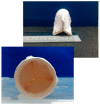Paramagnetic Functionalization of Biocompatible Scaffolds for Biomedical Applications: A Perspective
- PMID: 33260520
- PMCID: PMC7711469
- DOI: 10.3390/bioengineering7040153
Paramagnetic Functionalization of Biocompatible Scaffolds for Biomedical Applications: A Perspective
Abstract
The burst of research papers focused on the tissue engineering and regeneration recorded in the last years is justified by the increased skills in the synthesis of nanostructures able to confer peculiar biological and mechanical features to the matrix where they are dispersed. Inorganic, organic and hybrid nanostructures are proposed in the literature depending on the characteristic that has to be tuned and on the effect that has to be induced. In the field of the inorganic nanoparticles used for decorating the bio-scaffolds, the most recent contributions about the paramagnetic and superparamagnetic nanoparticles use was evaluated in the present contribution. The intrinsic properties of the paramagnetic nanoparticles, the possibility to be triggered by the simple application of an external magnetic field, their biocompatibility and the easiness of the synthetic procedures for obtaining them proposed these nanostructures as ideal candidates for positively enhancing the tissue regeneration. Herein, we divided the discussion into two macro-topics: the use of magnetic nanoparticles in scaffolds used for hard tissue engineering for soft tissue regeneration.
Keywords: hard tissue; hydrogel; magnetic nanoparticles; scaffold; soft tissue; tissue engineering.
Conflict of interest statement
The authors declare no conflict of interest.
Figures







Similar articles
-
Magnetic bioinspired micro/nanostructured composite scaffold for bone regeneration.Colloids Surf B Biointerfaces. 2019 Feb 1;174:70-79. doi: 10.1016/j.colsurfb.2018.11.003. Epub 2018 Nov 5. Colloids Surf B Biointerfaces. 2019. PMID: 30439640
-
Bio-plotted hydrogel scaffold with core and sheath strand-enhancing mechanical and biological properties for tissue regeneration.Colloids Surf B Biointerfaces. 2021 Sep;205:111919. doi: 10.1016/j.colsurfb.2021.111919. Epub 2021 Jun 10. Colloids Surf B Biointerfaces. 2021. PMID: 34126550
-
Investigation of background, novelty and recent advance of iron (II,III) oxide- loaded on 3D polymer based scaffolds as regenerative implant for bone tissue engineering: A review.Int J Biol Macromol. 2024 Feb;259(Pt 1):128959. doi: 10.1016/j.ijbiomac.2023.128959. Epub 2023 Dec 23. Int J Biol Macromol. 2024. PMID: 38145693 Review.
-
Comprehensive Review on Design and Manufacturing of Bio-scaffolds for Bone Reconstruction.ACS Appl Bio Mater. 2021 Dec 20;4(12):8129-8158. doi: 10.1021/acsabm.1c00949. Epub 2021 Nov 17. ACS Appl Bio Mater. 2021. PMID: 35005929 Review.
-
Biopolymeric hydrogels - nanostructured TiO2 hybrid materials as potential injectable scaffolds for bone regeneration.Colloids Surf B Biointerfaces. 2016 Dec 1;148:607-614. doi: 10.1016/j.colsurfb.2016.09.031. Epub 2016 Sep 22. Colloids Surf B Biointerfaces. 2016. PMID: 27694050
Cited by
-
Incorporation of Superparamagnetic Iron Oxide Nanoparticles into Collagen Formulation for 3D Electrospun Scaffolds.Nanomaterials (Basel). 2022 Jan 6;12(2):181. doi: 10.3390/nano12020181. Nanomaterials (Basel). 2022. PMID: 35055200 Free PMC article.
-
Magnetic Nanofibrous Scaffolds Accelerate the Regeneration of Muscle Tissue in Combination with Extra Magnetic Fields.Int J Mol Sci. 2022 Apr 18;23(8):4440. doi: 10.3390/ijms23084440. Int J Mol Sci. 2022. PMID: 35457258 Free PMC article.
-
Gelatin Meshes Enriched with Graphene Oxide and Magnetic Nanoparticles Support and Enhance the Proliferation and Neuronal Differentiation of Human Adipose-Derived Stem Cells.Int J Mol Sci. 2022 Dec 29;24(1):555. doi: 10.3390/ijms24010555. Int J Mol Sci. 2022. PMID: 36613995 Free PMC article.
-
Synthesis and characterization of growth factor free nanoengineered bioactive scaffolds for bone tissue engineering.J Biol Eng. 2022 Oct 17;16(1):28. doi: 10.1186/s13036-022-00303-x. J Biol Eng. 2022. PMID: 36253790 Free PMC article.
-
Recent Advance of Liposome Nanoparticles for Nucleic Acid Therapy.Pharmaceutics. 2023 Jan 4;15(1):178. doi: 10.3390/pharmaceutics15010178. Pharmaceutics. 2023. PMID: 36678807 Free PMC article. Review.
References
-
- Mukherjee S., Madamsetty V.S., Bhattacharya D., Roy Chowdhury S., Paul M.K., Mukherjee A. Recent Advancements of Nanomedicine in Neurodegenerative Disorders Theranostics. Adv. Funct. Mater. 2020;30:2003054. doi: 10.1002/adfm.202003054. - DOI
Publication types
LinkOut - more resources
Full Text Sources

